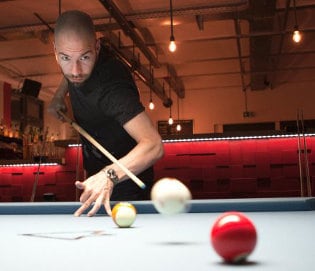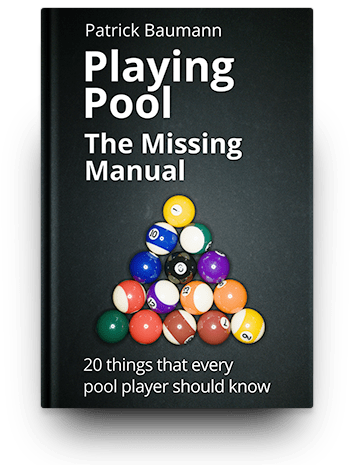Dieser Beitrag ist auch auf Deutsch verfügbar.
Mental strength is a mystic term. Like with “talent”, mental strength for many is a naturally given thing – you either have it or not. And if not, well, bad luck, you’ll just never going to win as often as a mentally strong opponent. However, I believe mental strength can be learned.
Mental training in pool or: “You can do it”?
Very often people try to gain mental strength by positive self-talk. You’re good, you’re strong, you’re gonna win. The problem is that often we don’t believe ourselves, and this self-talk distracts us more than it helps.
A piece of wood has to move on a straight line
But what does mental strength actually mean, practically spoken? Does it matter what kind of thoughts we have if our body does the right moves in the moment that counts? Which is, moving a piece of wood on a straight line? Positive thoughts, mental strength are only tools to make our arm go in the right direction. The actual stroke in pool only takes a short amount of the time we spend playing pool. During that time we have to be focused. If we manage to have a higher focus in these deciding moments, we’re mentally stronger.
We lack focus if we allow thoughts and feelings to distract us from the actual task. These thoughts and feelings can be the pressure of the match, noise, being unhappy with your technique, being annoyed by your opponent or trouble at work or in your family.
Don’t fight thoughts, let them go
A couple of months ago I started meditating with the app “Headspace” for smartphones, tablets and desktops. Meditation is basically about one thing: being focused on the current moment and the actual thing your doing. In the first couple of exercises in Headspace it’s always about focusing on the breath. When thoughts and feelings arise, you recognize them and let them go. Like sitting next to a road and watching cars pass. Because thoughts come and go; it’s about how much space you give them. You don’t fight thoughts and feelings. Instead you notice them, take a look at them and then let them go.
Also in daily life the task is to do things with more mindfulness and focus only on the task at hand. For example, one exercise early in the Headspace program is to recognize each time when you change your body position, for example sitting down.
You learn the skill of letting thoughts go and only focus on one thing like every other skill: by practicing. First thoughts keep coming up all the time, running through your mind, and you get lost in thoughts and feelings. But the more and more you practice, it becomes easier to just quickly recognize the thoughts and then get back to the actual task – to watch your breath.
When playing pool, this technique gives us superpowers. Different from the positive self-talk we don’t have to claim things that aren’t true. If our opponent is strong, we didn’t practice a lot recently or we’re just plain tired, we won’t believe the opposite anyway. We don’t have to forbid ourselves to have negative thoughts and emotions. Instead, with the described technique we can just notice these thoughts and let them go. And in the important moment of actually shooting the shot, we can focus on that one thing: moving a piece of wood on a straight line.






Thanks! Headspace is great!
Good stuff. Thanks!
Thanks, Paul!
Very good ! My brother is a pro pool player named Allen Hopkins. I will show him your site. 🙂
I know Allen Hopkins of course 🙂 Would be happy if you did that! Thanks!
I just bumped into this post. I’ve have a pretty rigorous meditation practice and recently started playing pool again after being away from it for many years. Connections between the meditation and pool seem like a good fit. There is a long tradition of meditation and movement, especially in the martial arts. I look forward to incorporating my meditation practice into my pool game.
Hi Ed, I didn’t think about martial arts and meditation, but you’re absolutely right. I’m glad you liked the post. Good luck with your pool comeback!
It’s really a great blog about billiards. The game of billiards its not very easy to play, we should train our self to an extreme to defeat our opponent. Work hard to hit mostly straight you will get the reward of it.
Agreed!
Great content and very helpful with billiard tips. Great work and hoping for more tips and tricks
Thank you so much!